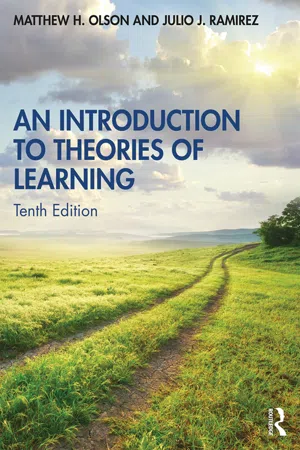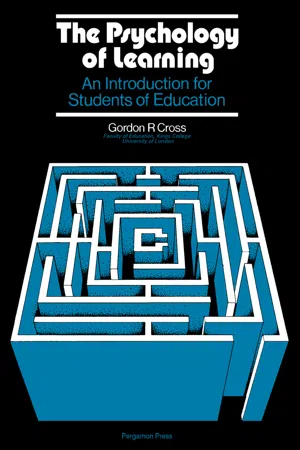Psychology
Edward Thorndike
Edward Thorndike was an influential psychologist known for his work in the field of behaviorism and learning theory. He is best known for his theory of "law of effect," which states that behaviors followed by positive consequences are more likely to be repeated, while behaviors followed by negative consequences are less likely to be repeated. Thorndike's research laid the foundation for the study of operant conditioning and animal behavior.
Written by Perlego with AI-assistance
Related key terms
1 of 5
8 Key excerpts on "Edward Thorndike"
- eBook - PDF
Theories of Human Learning
Mrs Gribbin's Cat
- Guy R. Lefrançois(Author)
- 2019(Publication Date)
- Cambridge University Press(Publisher)
Nevertheless, one of Thorndike’s very important contributions to the advancement of psych- ology is that he was largely responsible for the introduction of controlled investigations of animals and people as a means of verifying predictions made from theory. Critics also point out that Thorndike often appealed to vague internal states as a basis for explaining learning. Satisfying and annoying states of affairs are ill-defined and difficult concepts. As we see in Chapter 4, later theorists – especially Skinner – devoted considerable efforts to finding more objective ways to describe the effects of behavior. Despite the difficulties associated with Thorndike’s use of concepts such as “satisfiers” and “annoyers,” one of his most important contributions to the development of learning theory is the emphasis he placed on the consequences of behavior as determiners of what is learned and what is not. The significance of the law of effect in the development of learning theory is apparent in its long-lasting influence. The notion that the effects of reinforcement are central in learning has largely dominated psychology since Thorndike. Thorndike also made significant contributions in the practical application of psychological principles, particularly in teaching. A large number of his writings are devoted specifically to pedagogical problems in specific areas such as arithmetic (Thorndike, 1922), Latin (Thorndike, 1923), and the psychology of interest (Thorndike, 1935). Thorndike serves as an example of a theorist strongly committed to a clear and definite viewpoint, yet willing to examine other views, to make dramatic changes in his own thinking, and also to admit that there was still much that his theory could not explain. “The connectionist theory of life and learning,” he writes, “is doubtless neither adequate nor accurate. Its explan- ations of purposive behavior, abstraction, general notions, and reasoning are only a first and provisional attack on these problems. - eBook - PDF
- Matthew H. Olson, Julio J. Ramirez(Authors)
- 2020(Publication Date)
- Routledge(Publisher)
55 PART II PREDOMINANTLY FUNCTIONALISTIC THEORIES 4 57 CHAPTER OUTLINE Animal Research Before Thorndike 59 Major Theoretical Concepts 61 Connectionism 61 Selecting and Connecting 61 Learning Is Incremental, Not Insightful 63 Learning Is Not Mediated by Ideas 63 All Mammals Learn in the Same Manner 64 Thorndike Before 1930 64 The Law of Readiness 64 The Law of Exercise 65 The Law of Effect: Thorndike on Reinforcement 65 Secondary Concepts Before 1930 66 Multiple Response 66 Set or Attitude 67 Prepotency of Elements 67 Response by Analogy 68 Associative Shifting 70 Thorndike After 1930 71 Revised Law of Exercise 71 Revised Law of Effect 71 Belongingness 71 Spread of Effect 73 Thorndike on Education 73 Evaluation of Thorndike’s Theory 76 Contributions 76 Criticisms 76 Chapter Summary 77 It is fitting that we begin our discussion of the major learning theorists with Edward L. Thorndike (1874–1949), perhaps the greatest learning theorist of all time. He did pioneer work not only in learning theory but also in educational practices, verbal behavior, comparative psychology, intelligence testing, the nature-nurture problem, transfer of training, and the application of quantitative measures to sociopsychological problems (e.g., he developed scales with which to compare the quality of life in different cities). Thorndike began this latter project, as well as many others, when he was more than sixty years old. His research started with the study of mental telepathy in young children (which he explained as the unconscious detection on the part of the child of minute movements made by the experimenter). His later experiments involved chicks, cats, rats, dogs, fish, CHAPTER 4 EDWARD LEE THORNDIKE 58 PREDOMINANTLY FUNCTIONALISTIC THEORIES monkeys, and finally adult humans. He wanted to use apes also but could not afford to buy and maintain them. Thorndike’s scientific productivity was almost unbelievable. - eBook - PDF
The Psychology of Learning
An Introduction for Students of Education
- Gordon R. Cross, Edmund King(Authors)
- 2016(Publication Date)
- Pergamon(Publisher)
These activities are not easily learned until a child has reached a certain level of maturation which is determined by a coordination of mental development and physical growth. Thorndike is generally known by the three major laws of learning. He also proposed five subsidiary or subordinate laws, and these have some educational relevance : (a) The learner must be flexible and vary his approach in attempting to solve a problem until by trial and error he is successful, (b) The attitude or set of the learner is significant in determining his behaviour and success in learning, (c) The learner picks out the fundamental and essential points of an argument or problem and discards irrelevant details, (d) The learner responds to new or novel situations by drawing analogies with past experience or in identifying elements common to both, (e) The learner responds to a given stimulus, then by associative shifting transfers it to a totally different stimulus. This is closely akin to Pavlov's concept of classical conditioning discussed in a later section. 12 PSYCHOLOGY OF LEARNING Thorndike's influence on educational thought in the early part of the century was considerable in spite of its rigid and mechanical approach to learning in which trial and error, drill, rote memory and habit formation assume greater significance than understanding, experience, discrimination and motivation. Studying foreign languages by memorizing word lists, history by repeating important dates parrot fashion, geography by cram-ming facts into rigid regional classifications (the capes and bays approach) and mathematics by tricks and rules of thumb are all illustrative of Thorn-dike's pedagogy. Human behaviour demands fine discriminations, subtle movements and highly developed thought processes including abstract thinking, yet he never really explained how bonds or connections are chained and organized into complex intricate patterns. - George E. Stelmach(Author)
- 2014(Publication Date)
- Academic Press(Publisher)
History has lessons for us, we are told, and so it should attract us all. A benefit of history is the satisfaction of knowing our roots and basking in a lineage of important people and ideas. A benefit is perspective in seeing the ebb and flow of ideas. Another benefit is seeing what has endured from the past, what we have cast off, and what we have changed or keep trying to change. Without historical perspective, the enduring elements seem so natural and right that we never think of challenging them, the cast-off elements are forgotten, and the elements being changed appear as part of the modern flux and seem new to us. My topic is knowledge of results, or KR as we handily say, and I will base this discussion of human reinforcement on the work of Edward L. Thorndike (1874–1949). He gave us a strong push down the motor learning road, and it is instructive to look at this part of psychology’s history, see the legacies, and ask what they mean for us today.II Thorndike and His Ideas
Man has had an intuitive understanding of reward and punishment since his beginning, but it is only in the experimental era of psychology that we have subjected reward and punishment in instrumental learning to close scrutiny. Systematic thought on instrumental learning began with the animal research of Thorndike (1898) . A dimension of Thorndike’s early animal work was scientific objectivism as he reacted against the practice of his day that imputed human conscious processes, like reasoning, to animals, and in a few years this objectivism was complemented by the superobjectivism of John B. Watson (1913) and his behaviorism. Watson was more interested in Pavlovian conditioning than in the instrumental learning that fascinated Thorndike, and Thorndike was not an evangelist for behaviorism like Watson, but the two were allies in rejecting the mentalism of the past and in asserting objectivism in psychology. These two major figures in our history gave American psychology a strong interest in learning, and their mutual concern with objectivism got learning off to a hard-headed start.Thorndike’s (1898)- Erwin V. Johanningmeier, Theresa R. Richardson(Authors)
- 2010(Publication Date)
- Information Age Publishing(Publisher)
It made no difference how strong or how weak. Learning and what in ordi-nary language might be called “unlearning” are both learning. If school-ing were a process thoroughly consistent with Thorndike’s notion of learning, students who begin performing well and then proceed to do less well would be given credit for having learned. To the extent that the Progressive Era was an era of reform, an era that called for standardization in public education, accountability, and the means for providing measures to demonstrate accountability, Thorndike was indeed a major contributor with his laws of learning. The next section explores a different but related paradigm in the history of educational research. An underlying medical model pervades the establishment of the “new” social sciences out of the classic disciplines of philosophy, natural science, and rhetoric. Modern medicine and medical schools were models for post-graduate education and academic research that produced theo-ries that could be applied to real life and make a difference in health, education, and welfare. Major figures in psychology criss-crossed paths 266 E. V. JOHANNINGMEIER and T. RICHARDSON with medicine and psychiatry including William James, Thorndike’s men-tor, and G. Stanley Hall, his contemporary. NOTES 1. Edward L. Thorndike. Science, n. s. Vol. XXXVII (January 24, 1913), p. 42, Quoted in Merele E. Curti. The Social Ideas of American Educators, rev. ed. (Totowa, New Jersey: Littlefield, Adams & Co., 1959), p. 482. 2. Edward L. Thorndike, “Eugenics: With Special Reference to Intellect and Character,” Popular Science Monthly , Vol. LXXXIII (April 1913), pp. 131-132; also see: Robert L. Church and Michael W. Sedlack, Education in the United States: An Interpretive History (New York: The Free Press, 1976), p. 357. 3. David K. Cohen and Carol A. Barnes. “Research and the Purposes of Edu-cation,” in Ellen Confliffe Lagemann and Lee S.- eBook - PDF
Learning Psychology NQF4 SB
TVET FIRST
- N Horn P Huygen(Author)
- 2013(Publication Date)
- Macmillan(Publisher)
The point here is that the teacher should establish important points first, because first impressions are the strongest. To sum up, Thorndike ’ s theory involves establishing bonds between stimuli and responses. These bonds are created by repetition together with rewards for successful performances. In classroom terms, this amounts to a regime of repetition, drill, practice to secure the right responses and to make them habitual. A criticism of teaching methods based on this view is that, carried out unimaginatively, it leads to mechanical and routine cramming and to habit formation, and reduces individual initiative. The Behaviourist Theory of Learning Figure 1.5: In the classroom, it can be useful for learners to learn things by repeating them, but you must make sure the learners also understand what they are saying or doing. Work in groups . Think of at least two examples of how to use Thorndike ’ s four Laws of Learning. Think about how to apply the laws and the expected behaviour of the learner. Discuss your findings with the rest of the class. Your lecturer will use the following rubric to assess your work. Assessment criteria Comments 1 2 3 4 5 Organised and described the type of behaviour, type of learning and the role of the learner under each element of the Behaviourist Theory: operant conditioning. Proposed activities on how to apply the Behaviourist Theory in practice: operant conditioning. Scale: 1 = Not achieved (0–39%); 2 = Not yet competent (40–49%); 3 = Competent (50–69%); 4 = Highly competent (70–79%); 5 = Outstanding (80–100%) Learning activity 1.5 18 2 .3 .2 B . F . Skinner Skinner (1904–1990) formulated a more detailed theory of operant conditioning. His theory is based on reinforcement, punishment and extinction. His theory deals with changes in behaviour that can be observed and he ignores the possibility of any processes that may occur in the mind of the individual. - eBook - PDF
- Duane Schultz, Sydney Schultz, , , Duane Schultz, Sydney Schultz(Authors)
- 2015(Publication Date)
- Cengage Learning EMEA(Publisher)
Con-versely, prolonged disuse of the response tends to weaken the association. In other words, simply repeating a response in a given situation tends to strengthen that response. Further research persuaded Thorndike that the reward consequences of a response (a situation that produces satisfaction) are more effective than mere repetition of the response. Through an extensive research program using human subjects, Thorndike later reexam-ined the law of effect. The results revealed that rewarding a response did indeed strengthen it, but punishing a response did not produce a comparable negative effect. He revised his views to place greater emphasis on reward than on punishment as a way of changing behavior. Comment Thorndike’s investigations of human and animal learning are among the most sig-nificant research programs in the history of psychology. His work heralded the rise of Law of effect: Acts that produce satisfaction in a given situation become associated with that situation; when the situation recurs, the act is likely to recur. Law of exercise: The more an act or response is used in a given situation, the more strongly the act becomes associated with that situation. FIGURE 9.2 THORNDIKE’S PUZZLE BOX. © Cengage Learning Copyright 2016 Cengage Learning. All Rights Reserved. May not be copied, scanned, or duplicated, in whole or in part. Due to electronic rights, some third party content may be suppressed from the eBook and/or eChapter(s). Editorial review has deemed that any suppressed content does not materially affect the overall learning experience. Cengage Learning reserves the right to remove additional content at any time if subsequent rights restrictions require it. 200 Chapter 9 Behaviorism: Antecedent Influences learning theory to prominence in American psychology, and the objective spirit in which he conducted his research was an important contribution to behaviorism. Watson wrote that Thorndike’s research laid the foundation for behaviorism. - eBook - PDF
- Per Saugstad(Author)
- 2018(Publication Date)
- Cambridge University Press(Publisher)
282 12 Behaviorism an all-regulating principle of behavior. With this effort, he directed attention to new aspects of many psychological issues. He also developed an experimental technique for investigating the effect of consequences on behavior, based on Thorndike’s experiments. The Skinner Box Thorndike had shown that the time it took for the cat to get out of the cage could be interpreted as a function of the number of attempts it made. Skinner believed Thorndike had made a discovery, but he pointed out that the time it took for the animal to get out was dependent on what the animal could stumble upon by coincidence. The time was also dependent on which type of behavior the experimenter or the apparatus defined as successful. Thus, according to Skinner, the learning curve Thorndike had drawn up did not give an adequate picture of the learning processes involved. To attain better control of the processes Thorndike called “stamping in,” Skinner altered the cage so the consequences could be interpreted as direct consequences of the animal’s actions. He constructed a cage for the study of rats in which one wall was equipped with a lever and a food receptacle. These were connected so that pressure on the lever released a morsel of food or a drop of water into the cup from a reservoir. The reservoir could also be manipulated independently of the lever. With the help of this simple apparatus, which became known as a Skinner box (Figure 12.1), Skinner could arrange the setting so the rat obtained food or water only by per- forming a given type of behavior, as, for example, by depressing the lever. Skinner also constructed a similar apparatus for use with pigeons. In this, he replaced the lever with a plate that could be connected to a reservoir holding food or water. When the pigeon pecked on the plate, a bit of food or a drop of water would fall into the receptacle.
Index pages curate the most relevant extracts from our library of academic textbooks. They’ve been created using an in-house natural language model (NLM), each adding context and meaning to key research topics.







